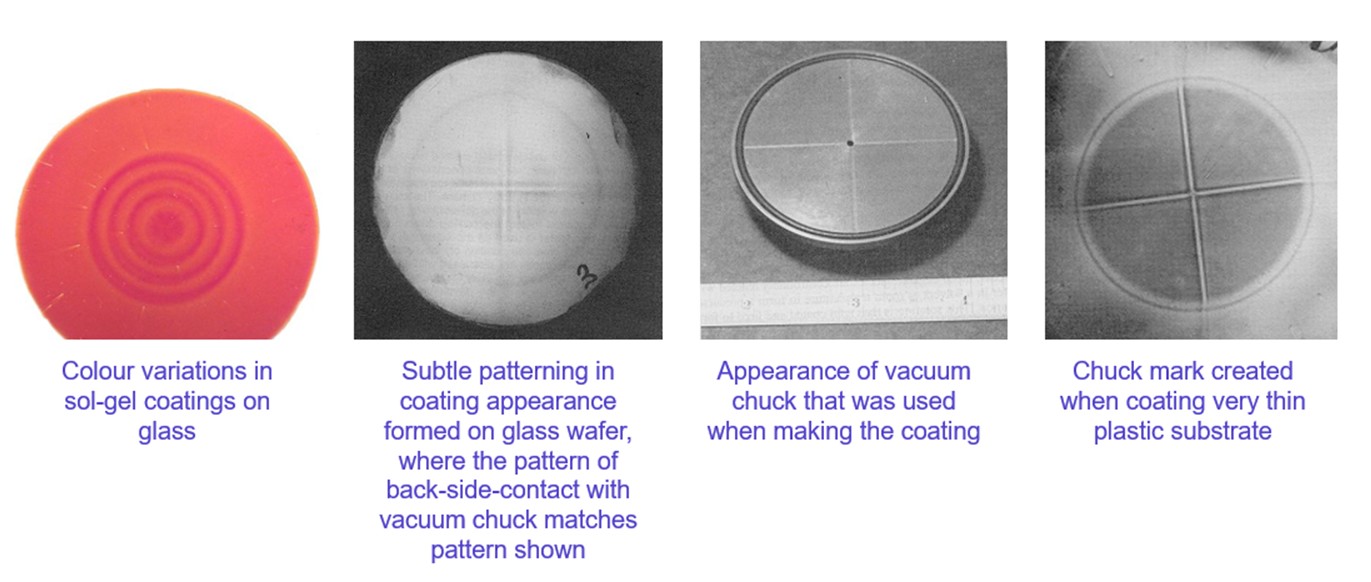
Ghost Chucks: A Haunting in the Lab
You’re working in a lab, late one night, when your eyes behold an eerie sight… wait, that’s the start of the Monster Mash 🎶🧛But it does set the scene nicely for today’s spooky science tale…
While fabricating multilayer interference devices, Professor Dunbar Birnie noticed ghostly patterns emerging in the sol-gel coatings being deposited onto glass substrates. Puzzling colour variations, indicating patterns of thickness variation, lingered after spin coating.
Working with a team of researchers, and with the support of SCS, Birnie designed an experiment to uncover the root of the ‘haunting’. Ellipsometry measurements revealed the darker (thicker) regions matched the areas in direct contact with the vacuum chuck, while thinner regions aligned with the grooves and gaps where contact was limited. Imaging confirmed the spectral pattern – the chuck’s concentric and cross-shaped grooves were distinctly visible through the coating.
Further experiments showed that thinner, flexible substrates revealed these “ghosts” most clearly. Surprisingly, even areas above the vacuum lines, where material might be expected to pool, were thinner, not thicker.
The culprit? Thermal conductivity.
Better heat transfer between the metal chuck and coating solution created tiny local temperature differences, influencing how the sol-gel deposited. Though the coating never touched the chuck directly, subtle thermal “communication” through the substrate left behind detailed chuck marks - true contact from the other side.
So how can these ghoulish sights be banished?
· Choose porous chucks for more uniform chuck-substrate contact to minimise thermal effects
· Choose a Delrin or Teflon chuck with much lower thermal conductivities
· Control coating and drying conditions to promote uniform solvent evaporation.
· Review handling and surface prep to ensure both chuck and substrate are smooth, clean and free from contaminants.
This research formed part of a broader investigation into spin coater dynamics - building the foundation for many of today’s thin-film and coating technologies.
Chuck Marks in Sol-Gel Coatings (Dunbar P.Birnie, lll)
Department of Materials Science and Engineering, Rufgers, The State University of New Jersey

To ward off any spooks and ghouls in your coatings, equip your lab with high-quality wafers, custom chucks, and precision spin coaters. For over three decades, PI-KEM has partnered with SCS to provide researchers with the reliable, high-performance equipment essential for successful coatings and materials research: Spin Coaters & Chucks | PI-KEM
To learn more about how PI-KEM can help you choose the right chuck for your spin coating, visit A Guide to Chuck Selection for Spin coating Success
If you have ghouls haunting your processes, speak to our experts today:
Colin Rouse | Managing Director, Group Technical Expert
Tyler Williams | Sales Development Executive, Energy Research & Material Processing



